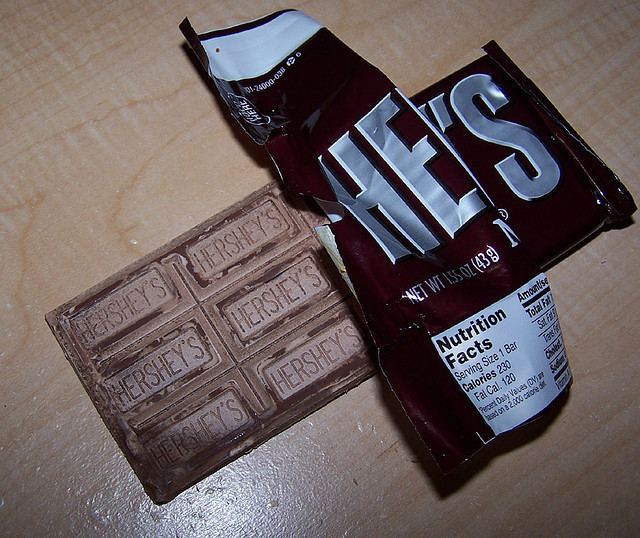 | ||
Chocolate bloom is a whitish coating that can appear on the surface of chocolate. This effect is one of the main concerns in the production of chocolate. There are two types of bloom: fat bloom, arising from changes in the fat in the chocolate; and sugar bloom, formed by the action of moisture on the sugar ingredients. The crystals of fat and sugar bloom limit the shelf life of many chocolates. Chocolate that has "bloomed" is still safe to eat (as it is a non-perishable food due to its sugar content), but may have an unappetizing appearance and surface texture. In general, Chocolate bloom can be 'repaired' by melting the chocolate down, stirring it, then pouring it into a mould and allowing it to cool, bringing the sugar or fat back into the solution.
Contents
Fat bloom
A great deal has been written about chocolate fat bloom. It is generally accepted that visual fat bloom in chocolate is the cocoa butter that has separated toward the surface.It is caused by:
There is no single universally accepted theory that describes fat bloom in chocolate. Current theories about fat bloom fall into two categories: polymorphic transformation and phase separation theory.
Phase separation theory
According to this theory, storage bloom is due to phase separation of the triglycerides within the crystalline structure of cocoa butter. This theory is based on the fact that butter is a mixture of diverse triglycerides and each type of triglyceride has a unique melting temperature. At higher temperatures, the lower melting point triglycerides in cocoa butter will melt and this liquid phase occupies a greater volume than the solid. The liquid phase will then be squeezed out to the surface through fissures or pores in the chocolate. After the liquid phase reaches the surface, the triglycerides will recrystallize into the less stable form (alpha crystals), with bloom occurring.
Polymorphic transformation
In cocoa butter, there are six essential polymorphic forms. The polymorphic transformation theory is based on the fact that bloomed chocolates are always found to contain the most stable VI polymorph of cocoa butter. According to this theory, bloom occurs through the uncontrolled polymorphic transformation of cocoa butter from a less stable form (form IV or V) to the most stable form (form VI). The technology of good chocolate production depends on ensuring that only the stable form of the cocoa butter ingredient exists in the final product. In poorly tempered chocolate, form IV will transform to V and eventually form VI, resulting in bloom, while in well-tempered chocolate, form V will transform to form VI and bloom may also occur. Elevated and/or fluctuating temperatures promote the transformation rate and thus also promote the rate of bloom formation. However, it is found that the production of form VI from form V does not always lead to bloom; a direct relationship cannot be established between fat bloom and the evolution of the crystalline forms. The onset of transformation from form V to form VI crystals is not the cause of visual bloom; rather, this transition should be considered as an aspect of cocoa butter recrystallization that may result in bloom.
Methods to minimize fat bloom
Sugar bloom
While the most common is fat bloom, sugar bloom also occurs and is not necessarily distinguishable from the fat bloom by appearance. In freshly sugar bloomed samples, it is often easy to feel the surface difference; sugar bloom feels dry and does not melt to the touch, while fat bloom feels slick and melts. One can often see the difference by touching a small droplet of water to the surface. With fat bloom, the droplet simply beads up. With sugar bloom, the droplet quickly flattens and spreads, as the water dissolves the microscopic sugar particles on the surface (Seguine, 2001). Alternatively, gentle warming of the surface (with a hairdryer, for example) will cause the crystals of fat bloom to melt, removing the appearance of bloom, while leaving sugar bloom unchanged.
Sugar bloom is caused by moisture. Condensation on to the surface of the chocolate or moisture in the chocolate coating causes the sugar to absorb the moisture and dissolve. When the moisture evaporates, the sugar forms larger crystals, leaving a dusty layer. It is caused by:
